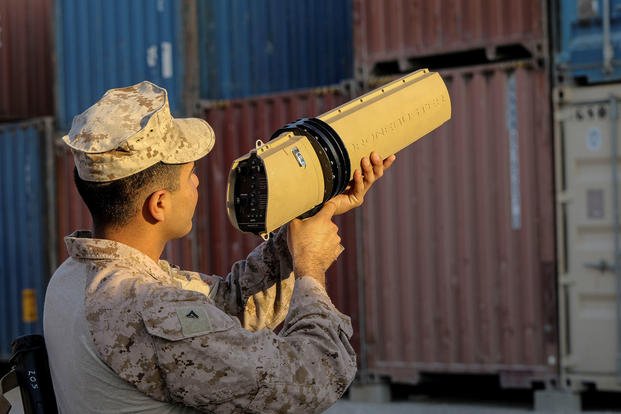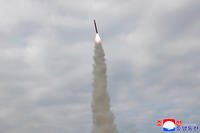A Marine base in Guam "disabled" a drone flying over the installation Sunday, prompting a Naval Criminal Investigative Service inquest and a warning to the public that unmanned aerial systems are prohibited on Defense Department property, according to the service.
The incident occurred at Camp Blaz, a fairly new base that was established last year in an effort to boost the Corps' presence in the Indo-Pacific against Chinese influence in the region. When asked, a spokesperson for the Marine Corps would not say whether it was a civilian or foreign drone that was shot down, citing the ongoing NCIS investigation.
Earlier this month, commanders in charge of two Pacific-aligned rotational units said that unmanned aerial systems, or UAS, were a "wicked problem" that they did not have assets to combat on their own. In a press release the following week, the Marine Corps touted how it was "one step closer to defeating" UAS as it urgently works to bring the capability to Marines' hands.
Read Next: The Army Recruiting Ad Featuring a Soldier with 2 Moms Just Got Harder to Find. Here's Why.
"On Jan. 14, a drone flying over Marine Corps Base Camp Blaz was disabled," Maj. Diann Rosenfeld, a spokesperson for the base, told Military.com on Monday. "NCIS is investigating the incident. As a public reminder, drone activity over Guam DoD property is prohibited."
When pressed for details, Rosenfeld declined to specify how the drone was disabled, whether it was an incident originating from a civilian-operated drone, or if the incident was related to national security.
"Due to the ongoing NCIS investigation, I'm unable to provide more context," Rosenfeld said.
Meanwhile, the Corps said that in December it had successfully tested the Marine Air Defense Integrated System, or MADIS, a short-range anti-drone system that can be mounted on two tactical vehicles. On multiple occasions, leaders emphasized the urgent need for counter-UAS capabilities, to include the MADIS.
"The importance of countering UAS threats cannot be overstated," Col. Andrew Konicki, program manager for the Corps' Ground Based Air Defense program, said in a press release Friday. "We see it all over the news. MADIS is the key. We're excited to get this out to Marines."
The test included "hitting several launched drones" during a live-fire test in Yuma, Arizona, according to the press release. The MADIS system tracked and hit multiple drones using Stinger missiles and a 30mm cannon, a more robust anti-drone weapon than a Dronebuster, a handheld "gun" that uses radio frequencies to jam UAS.

"MADIS can complete the entire kill chain, and we witness[ed] that during this event," Konicki said. "It is a linchpin for mission success and our ability to neutralize airborne threats ... which in turn, increases our lethality."
The release said that the 3rd Littoral Anti-Air Battalion, which is located at Marine Corps Base Kaneohe Bay, Hawaii, will receive the first batch of MADIS after testing continues throughout the next year. The anti-air battalion, which was activated in 2022, provides "critical support and protection" for Marines in the Pacific, according to the service.
While it is unclear what method was used to zap the drone over Camp Blaz, the Marine Corps will roll out the Installation Counter Unmanned Aircraft Systems, or I-CUAS, this year to defend American assets and installations in the U.S. and its territories.
For some units, it appears counter-drone capabilities cannot come soon enough. In a reporter roundtable with representatives from Marine Rotational Forces Darwin and South East Asia earlier this month, commanders for those units expressed a need for the tools.
Unmanned aircraft systems are "a wicked problem that everyone's working hard to come to grips with," Col. Brendan Sullivan, the commanding officer of Marine Rotational Force-Darwin, or MRF-D, told reporters.
Sullivan, along with Col. Thomas Siverts, the commanding officer of the newly formed Marine Rotational Force-South East Asia, or MRF-SEA, said that, while they did not encounter any foreign UAS on their most recent rotations, they did not have counter-drone capabilities organic to their units and had to rely on Pacific partners for the task.
Instead, the units managed their "signatures," meaning they reduced their risk of detection by enemy drones that might collect information on their position and assets.
"We've taken multiple disparate commercial off-the-shelf and government off-the-shelf technologies and put them together," Konicki, the program manager, said in the press release regarding the MADIS testing. "This is a capability the Marine Corps has never had, and it was a challenge for the acquisition community. This test event shows we met that challenge."














